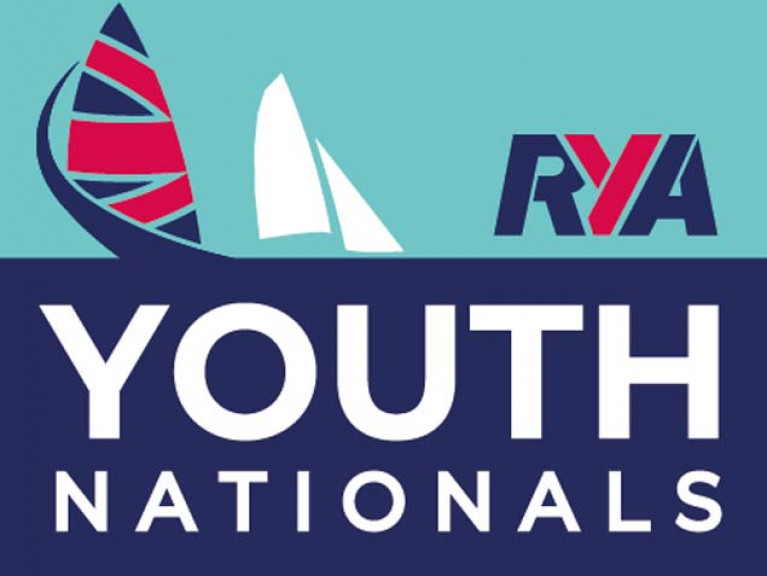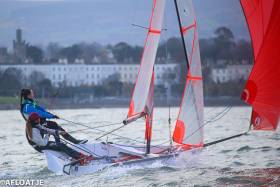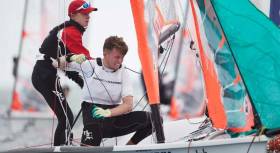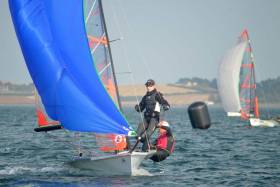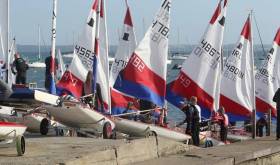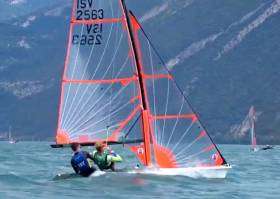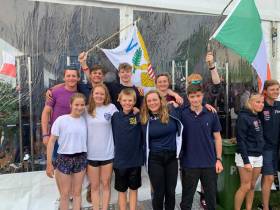Displaying items by tag: youth sailing
Windfoiling Debuts at 2020 RYA Youth Nationals
The RYA Youth Sailing National Championships will enter an exciting new era in 2020 with the latest Olympic discipline of wind foiling set to make its debut.
Windfoiling, an evolution of windsurfing, will replace the RS:X at the Paris 2024 Olympics and will be the third class to 'fly' alongside the Nacra 17 and Formula Kite.
To ensure that youth racing in the UK remains at the cutting edge of the sport, the RYA Youth Nationals will feature three foiling windsurfing fleets racing Starboard IQFoil boards.
It follows the introduction of kitefoiling, another new Olympic discipline, at the 2019 regatta, the UK's premier youth racing event.
Kitefoiling returns to the Youth Nationals in 2020 alongside the highly-contested Laser, Laser Radial, 420, Nacra 15 and 29er - all British Youth Sailing Recognised classes.
Entries are now open to the Youth Nationals, which will be hosted at Plas Heli, the Welsh National Sailing Academy and Events Centre, from April 3 to 10.
Sailing's Bateman Brothers Win Cork City & County Youth Sport Award
Youth Sailing duo Chris and Olin Bateman have been awarded November's Cork City and County Youth Sports Award at The Metropole Hotel in Cork City this week.
The Royal Cork and Monkstown Bay sailors were honoured for their win of Irish Sailing's Junior All Ireland Sailing Championships in Schull in October.
Among the gathering at the Metropole were Joe Kavanagh Deputy Lord Mayor, Deputy County Mayor Cllr. Audrey Buckley and Cllr. Marcia D’Alton.
Speaking at the ceremony Sponsor John Buckley of John Buckley Sports, said: “we are here to honour two brothers with a number of firsts for these awards".
It was the first time the scheme had awarded brothers, the first time it had honoured someone so young and it was also the first time the sport of sailing had been recognised.
Olin accepted the award on behalf of himself and his older brother who is currently away sailing a 49er skiff in Villamoura during his Christmas school holidays.
 Deputy County Mayor Cllr. Audrey Buckley, John Buckley Award Sponsor, Olin Bateman, Roger Russell Gen Manager of the Metropole Hotel (main sponsor) and Deputy Lord Mayor Cllr. Joe Kavanagh
Deputy County Mayor Cllr. Audrey Buckley, John Buckley Award Sponsor, Olin Bateman, Roger Russell Gen Manager of the Metropole Hotel (main sponsor) and Deputy Lord Mayor Cllr. Joe Kavanagh
Irish Youth Sailing National Champs Entry Opens
Entry is now open for Irish Sailing’s Annual Youth National Championships, taking place 16-19 April 2020 and hosted by Howth Yacht Club in County Dublin.
As Afloat reported earlier, this year, for the first time, the 29er class will be joining the Laser Radial, Laser 4.7, 420, Topper and Optimists.
The Youth National Championships were started first as a means for Irish Sailing coaches to spot burgeoning young talent, and pick members for the Pathway Teams and further coaching. The event has now grown in size and purpose to be Ireland’s largest youth regatta with over 200 young sailors and their families attending each year.
As well as racing, the programme will include expert speakers who represent different aspects of the sport, the opportunity to learn more about the Irish Sailing Performance Pathway, meet the coaches, as well as gather in one place to have fun and socialise.
Register here
Irish Sailing’s annual Youth National Championships will include skiff racing for the first time when they take place next year on 16-19 April at Howth Yacht Club, Dublin.
This year for the first time Irish Sailing has invited the 29er class to take part in the Youth Nationals. Irish Sailing has been working closely with the class over the past year and seen their numbers grow, reflecting the interest young Irish sailors have in this particular boat.
Jarlath O’Leary, Chair of IRL 29er Class said ‘’We are delighted at this recognition by Irish Sailing of Ireland’s fastest-growing dinghy class. It serves to reward and encourage the efforts of all our dedicated sailors, coaches and supportive parents who have done so much to put our class to the forefront of competitive youth sailing’’.
The 29ers will be joined by the five regular classes seen at the Youth Nationals: the Laser Radial, Laser 4.7, 420, Topper and Optimist.
The Youth National Championships were started first as a means for Irish Sailing coaches to spot burgeoning young talent, and pick members for the Pathway Teams and further coaching. The event has now grown in size and purpose to be Ireland’s largest youth regatta with over 200 young sailors and their families attending each year. As well as racing, the programme will include expert speakers who represent different aspects of the sport, the opportunity to learn more about the Irish Sailing Performance Pathway, meet the coaches, as well as gather in one place to have fun and socialise.
World Sailing’s Bermuda Decisions Will have Longterm Significance as Young People Become the Real Adults
What’s with today’s teenagers? Time was when your average teen aspired to sleep for 24 hours every day. The reason they slept for 24 hours every day was there were only 24 hours in the day. Move the dial-up to have a 28-hour day, then they’d pile on the zzzzs through that as well. As for sustenance, any brief moments of wakefulness would be used to consume the meatiest greasiest burgers that could be easily procured…..
Yet in sailing today, the young folk in Ireland who are filled with enthusiasm and seemingly endless vitality as they buzz around afloat and ashore with Optimists, Toppers, 420s, Lasers, 29ers, RS 200s and whatever – well, they simply knock the old-fashioned caricatures of teenagers for six.
Maybe those teenagers in the traditional mould were us. For the present wave of young pace-setters don’t just represent a step change, they seem to embody a total generational turnabout which makes today’s “adults” look like a self-indulgent planet-wrecking bunch of slobs. In fact, some of today’s most globally-prominent adults seem to be the kids chucking the toys out of the pram, while the leading young people appear to be the only adults in the room.
 Laura Dekker of The Netherlands during her round the world voyage, which she completed while still 16 in 2011.
Laura Dekker of The Netherlands during her round the world voyage, which she completed while still 16 in 2011.
 Laura Dekker’s boat was the Jeanneau Gin Fizz 40 Guppy
Laura Dekker’s boat was the Jeanneau Gin Fizz 40 Guppy
Such thoughts will emanate from many contemporary situations, but they particularly struck home from the recent World Sailing annual gathering in the appropriately exotic and geographically isolated setting of Bermuda. From this high-powered gathering – in which Ireland is well-represented in several groups, for dedicated committee work is in our genes – there emerged many decisions and several probable lines of progress.
But most conspicuously of all, they produced the names of the female and male Rolex World Sailors of the Year, and the latter was just 15 years old. That is certainly making the oldies wonder a bit, and then some. But deciding on the winners of such almost impossibly august titles in what aspires to be accepted as a generally equitable method is a mighty task in itself, and World Sailing’s technique is to rely 50% on public voting and 50% decision by the administrators.
Cynics will observed that the two winners come from two of the world’s most numerically large classes, the Lasers and the Optimists. Someone working on your behalf - for you should never do such things personally - will simply have to get your class mates to vote in droves in your favour. Except that it’s usually not actually simple at all - many sorts of stratagems may need to be deployed – but we can imagine that when massively large numbers of votes arrive to boost the chances of a very specific candidate, the final decision-makers are pushed towards their choice in a narrowing channel.
 Anne-Marie Rindom and Marco Gradoni with their World Sailing awards in Bermuda
Anne-Marie Rindom and Marco Gradoni with their World Sailing awards in Bermuda
And who could possibly disagree with their selection of Denmark’s Anne-Marie Rindom (28) as the female Sailor of the Year? Her sailing of a Laser Radial to the World Championship and other major titles is done in so utterly natural a way that you get the impression you’re watching a single unified living creature finding the optimum route through the weaving wind and wave-textured sea. Woman and boat become one.
Yet her route to the top wasn’t exactly meteoric. She may have been 21 – at the time thought relatively young – when she first sailed in the Olympics at Weymouth in 2012, but her 13th overall could best be described as “so-so”.
However, by the 2016 Olympics at Rio, she was more into her stride, and she and Ireland’s Annalise Murphy made for a formidable pairing of competitive mates out on the race course, with Murphy getting the Silver while Rindom took the Bronze. The entire final race was edge-of-the-seat stuff for spectators and participants alike, though some top sailors tell us that when you’re actually in the midst of it all, it’s like a sort of out-of-body experience in which you too are a spectator.
Once it was over, any remaining reality disappeared, and Murphy and Rindom abandoned their boats for a while as they jumped into the waters of Rio - not recommended at all by the public health authorities, but then all rules go by the wayside when a couple of Olympic medals are claimed.
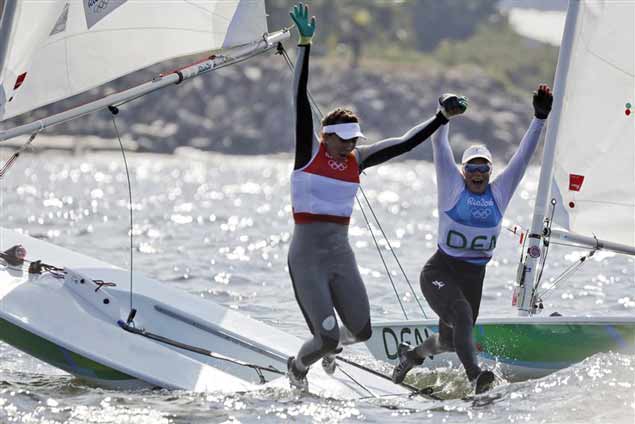 Ireland’s Silver Medallist Annalise Murphy and Demark’s Bronze winner Anne-Marie Rindom take a leap into the murky waters of Rio after their successful conclusion to the Olympic Regatta of 2016.
Ireland’s Silver Medallist Annalise Murphy and Demark’s Bronze winner Anne-Marie Rindom take a leap into the murky waters of Rio after their successful conclusion to the Olympic Regatta of 2016.
Since then, Annalise has been testing a couple of alternative possible sailing career routes before returning to the familiar embrace of the Laser Radial challenge of taking Ireland’s already-secured place in the class in the 2020 Olympics. But - by and large - Anne-Marie has stuck to the knitting, and her Laser Radial sailing has been elevated to a new level, putting her in the unenviable position of being a hot favourite for the Gold at Enoshima, which has something of the poisoned chalice about it.
Yet for now, she’s the Women’s World Sailor for 2019, and that’s enough to be going along with for the time being, even if those addicted to the numbers game cannot help but notice that the Laser has been in the career path for World Sailors three years in a row, with 2018’s Carolijn Brouwer and Marie Roux including the legendary Kirby design in their extensive sailing CVs, while in 2017 it was Marit Bouwmeester of the Netherlands for straightforward overall victory in the Laser Radial Worlds.
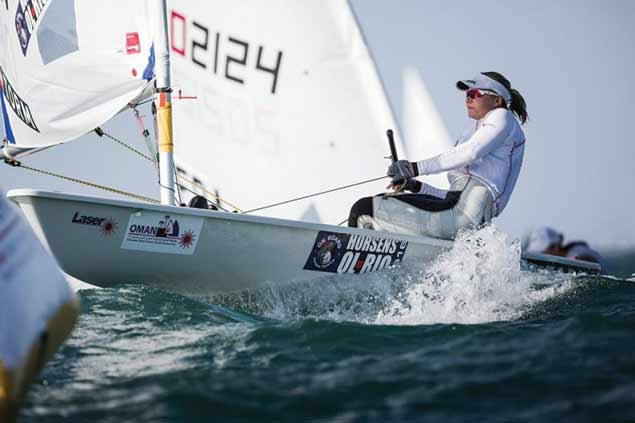 Anne-Marie Rindom in her element – she and her Laser seem blended like a single unit when sailing, and she is the first Dane to become a World Sailor of the Year.
Anne-Marie Rindom in her element – she and her Laser seem blended like a single unit when sailing, and she is the first Dane to become a World Sailor of the Year.
One of the most surprising aspects of the Rindom award is that it’s the first time any Danish sailor has won the top title, but it’s a surprise which pales in significance when set against the fact that the new Men’s World Sailor of the Year is just 15 years old.
We’re well aware this fact is old news for those for those whose primary interest in sailing is the global sport at its top level. But for the rest of us, bumbling around out local classes and club events and regional championships and all the other niche interests which sailing brings, it’s a relatively new fact that really needs to be taken out and set up on a pedestal and contemplated in detail.
For what sort of a world is it when an admittedly hugely-talented sailor like Italy’s Marco Gradoni becomes the global Sailor of the Year at the age of 15?
It’s not so very long ago – indeed, it’s still the situation in significant parts of the media – that editors were reluctant to publish anything in detail about the sporting activity of people under the age of 17. You could get high-flown reasons such as the fact that you were depriving them of their childhood by doing such a thing, and at a more hard-nosed level, you’d get the blunt response that most readers simply weren’t interested in the sport of other people’s kids. They wanted to read about adults facing distinctly adult challenges in which they were ultimately responsible, whereas with reporting your junior sport, there’s always the parent factor. That’s something which you disregard at your peril, making it an area where old-fashioned journos don’t wish to go at all.
It was a viewpoint which seemed to be supported - to take just one example - by the rules of the Rolex Sydney-Hobart Race, which set the lower age limit for participants at 18, despite the fact that several young people have been well into global solo circumnavigations by the time they’re 18, while the Dutch schoolgirl Laura Dekker had completed it by 16.
The reality is that chronological age is an extremely crude instrument with which to measure any individual’s maturity or abilities, and in an ideal world, it would be just one of a whole battery of assessment tools used to provide the complete picture. But we live in a very far from ideal world where such measurement luxuries aren’t widely available, and when the public hear that a 15-year-old has been crowned as the World Sailor of the Year, they immediately summon up their own cliched vision of a “typical” 15-year-old, and respond accordingly – frequently with derision.
Happily, in the more focused world of Irish sailing, we’ve become accustomed to the shifting and rapidly developing focus of the new wave – after all, this is the Greta Thunberg generation – and before the news was announced that Marco Gradoni had been judged top of the tops, we’d lived for a while with knowing that Eve McMahon - aged just 15 yet long since moved on from Optimist sailing – is one of four women sailors looking to take Ireland’s Laser Radial place in Japan next year.
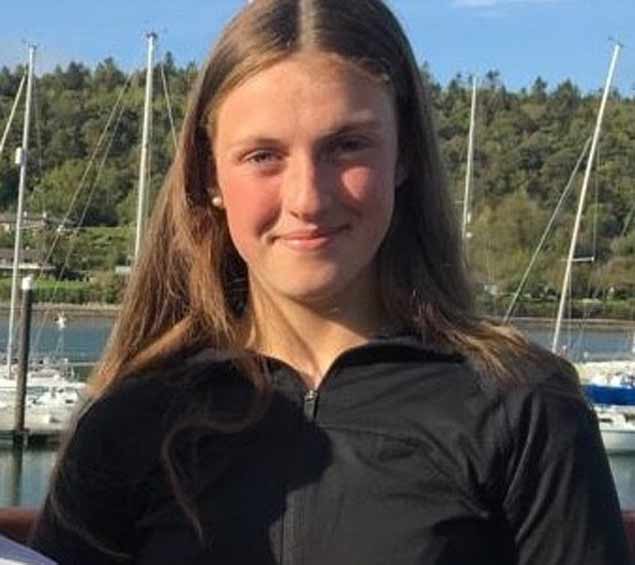 Eve McMahon – changed attitudes towards the maturity of today’s young sailors means that her nomination at age 15 to challenge for an Olympic place is seen in a positive light.
Eve McMahon – changed attitudes towards the maturity of today’s young sailors means that her nomination at age 15 to challenge for an Olympic place is seen in a positive light.
Five years ago we might have said she’s far too young to think of such a thing. But we live in time of unprecedentedly rapid change in attitudes, and in this weird year of 2019, many of us found ourselves thinking: “Fair play to her”. In fact, the Eve McMahon story is at the more interesting stage, while Gradoni’s title marks a conclusion, albeit a great one. He’s at the upper limit age-wise for Optimist sailing, and his victory at the Worlds in Antigua in July – his third in a row – benefited from the good breezes of the venue to off-set his increasing size challenge.
 In 2019, at age 15 Marco Gradoni was veering towards the hefty size for competitive Optimist campaigns, but the brisk winds of Antigua worked in his favour at the Worlds, and after winning his third Worlds in a row, he celebrated in classic style. Photo: Optimist Class/Matias Cappizano
In 2019, at age 15 Marco Gradoni was veering towards the hefty size for competitive Optimist campaigns, but the brisk winds of Antigua worked in his favour at the Worlds, and after winning his third Worlds in a row, he celebrated in classic style. Photo: Optimist Class/Matias Cappizano
Three Optimist World titles in a row is unprecedented, and in Gradoni’s case they mark the peak of a wide range of achievement, as he has won just about every major Optimist event in which he has competed since he took his first Worlds at the age of 13 in Thailand in 2017 in a fleet drawn from 65 nations, his successes including emerging first out of 940 boats in the Garda Meeting in 2018.
He’s both a successful solo sailor and a good team player, and while the images show that – like Anne Marie Rindom – he’s at his best when in a boat, he’s comfortable with himself ashore, and mature beyond his years, as is seen in this vid of him receiving the award in Bermuda:
Inevitably there were those present – and commentators subsequently – who have said someone so young should not get such a title, the responses including queries like what on earth young Marco will be able to do with the rest of his sailing life, which will now have to be in other boats.
Certainly, a very reliable source who was in Bermuda tells us that the idea of a lower age limit in future for the title was certainly in the air. But it seems to many that all his stars were in conjunction, that vital little bit of luck was on his side, and it would have been grossly unfair if Marco Gradoni had not become the World Sailor of the Year 2019.
And of course, it means that both titles have gone to European sailors, one from Scandinavia and the other from a Mediterranean country. Our battered old Continent deserves a bit of encouragement right now, for while the focus will swing to Japan for the Olympics next year and the America’s Cup in New Zealand in February 2021, the inexorable countdown to the 2024 Olympics in France will be living with the absence of the European-conceived Finn, once seen as the very essence of the European Olympic sailing spirit.
The Finn has been part of the Olympics since 1952. A mighty animal of a single-hander, racing a Finn is the apotheosis of athletic strength in sailing, providing a marked contrast with the gymnastics of the 49er. But with the final Olympic appearance at Enoshima next July (notwithstanding a last-ditch series of heartfelt appeals by Finn fans in Bermuda), the Finn is now on her way into history, while the future is focusing on the new mixed two-person offshore racer making its debut in France’s Olympics in 2024.
2024 may seem remote future for many, but in terms of putting a new fully-tested offshore racer together and in commission, it’s just around the corner, and in Bermuda, the timeline outlined towards selecting the preferred “equipment” (that’s what boats become in Olympic-speak) is tight enough. The official statement said:
“The criteria for suitable Equipment for the Mixed Offshore qualification events will be published no later than 31 December 2020. At the same time, an additional set of criteria will be published for the Paris 2024 Olympic Games Equipment. The recommendation also stated that the Equipment for Paris 2024 will be selected no later than 31 December 2023”.
The dream showbiz scenario would be to have six or so boats contending for the Olympic position as we near 2024, and then have all six on show at the Paris Boat Show in December 2023, with the announcement of the selected boat being made at the Show. Stranger things have happened in the Olympic circus……
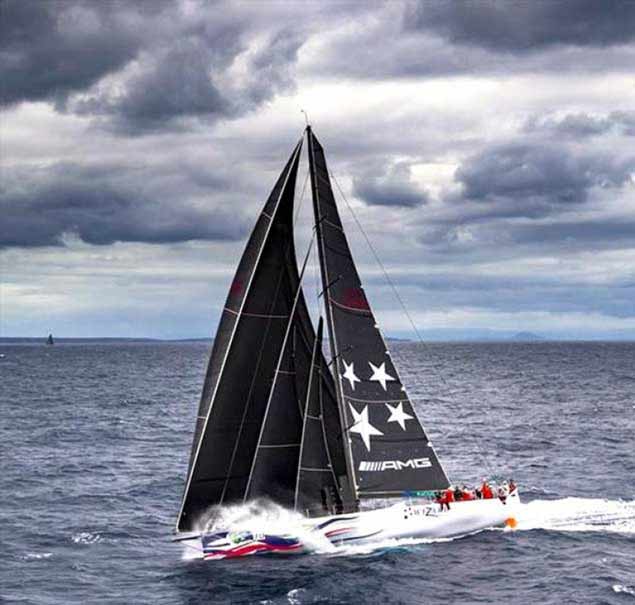 David & Peter Askew’s comprehensively successful Volvo 70 Wizard was voted the World Sailing Hempel “Team of the Year” 2019 in Bermuda.
David & Peter Askew’s comprehensively successful Volvo 70 Wizard was voted the World Sailing Hempel “Team of the Year” 2019 in Bermuda.
Meanwhile, Denmark has its first World Sailor of the Year to celebrate, and we can also take time out to think that the new World Men’s Sailor of the year is too young to have a driving licence or vote in local and national elections, yet in sailing today it seems right and proper that he’s top of the tops.
But then we can make that assertion safe in the knowledge that our favourite boat and crew in 2019, David & Peter Askew’s re-vamped Volvo 70 Wizard from the US, was confirmed as the World Sailing Hempel Team of the Year 2019 at the Bermuda gathering. She’d a dream of a year to win overall in the RORC Caribbean 600, the Transatlantic Race, and the Rolex Fastnet Race - an un-matched trio of classic successes in the space of just six months.
Ballyholme Yacht Club's Junior Icebreaker Series Goes Afloat
Adverse weather with strong gusts in the lead up to this week’s racing threatened to spoil the day again for this week’s Charles Hurst Jaguar Land Rover sponsored Junior Icebreaker at Ballyholme Yacht Club on Belfast Lough. Saturday morning however brought warm weather and light winds and a fleet of 18 junior sailors in their Topper dinghies were able to take to the water for their first training session followed by racing.
The course was set close to the clubhouse, which lead to tricky conditions in the light and shifty winds that were blowing from the shore. Race 1 saw Daniel Palmer lead from start to finish with Katie Brow in second and last year’s overall winner Faye McCartan rounding off the podium.
The second race saw a big shift on the left side of the course favour all those who had ventured in that direction seeing Daniel Palmer once again take line honours from Charlie O’Malley with Hannah Archer in third and Katie Brow staying in contention overall in fourth.
The third and final race was started in lighter winds but this time both sides of the course were even. Daniel Palmer made it a hat trick of first places but had to work this time to overtake Katie Brow who led at the first mark. Charlie O’Malley was third in this breakaway group and these three now lead the series overall.
Tight racing in the chasing pack was led by Romy Maguire ahead of Rex Claney in fifth place and Isobel Nixon in sixth.
Three of the entries were using the smaller 4.2 sail. This group is led by Hannah Bell with Charlotte Cairns second and Desi Gillespie in third. Even with the smaller sails this group were in the mix beating some of the sailors with full rigs.
The Junior Icebreaker takes place on Saturdays in October and November. Young sailors take to the water for training from a group of dedicated coaches. Training is followed by racing which is taken by these sailors as seriously as the adults in the main series on Sunday.
Kohls Win 29er Triple Crown in Much Improved Irish Fleet
The 29er Northerns was raced in Strangford Lough Yacht Club last weekend as part of the 30th RYA NI Youth Sailing Championships as Afloat reported earlier. It was the final event of the '29er triple crowns'. Nine teams competed: 3 all boys, 5 mixed and an all girls crew. The standard of the fleet has progressed at a stellar pace allowing a competitive regatta with many changes of leads.
Saturday started with a lot of wind which rapidly decreased to deliver 3 races in medium conditions. The high number of laps on offer allowed many close battles at marks and the sailors had to be solid on their boat handling to maintain or gain positions.
Elysia O'Leary and Chris Bateman showed skills and speed taking the first race win ahead of Triple crowns leaders Lola and Atlee Kohl. The second race saw the return of ISAFs YW Rian McDonnell-Geraghty and Nathan Van Steenberge to winning affairs with O'Leary-Bateman hot on their heels. The final race of the day saw an increase in wind strength and provided some drama.
"The standard of the fleet has progressed at a stellar pace allowing a competitive regatta with many changes of leads"
The leaders of the fleet did not see a lap had been added on the Race committee boat. The Kohl's siblings, on the other hand, had no hesitation and went on for the extra lap with McDonnell-Van Steenberge right on their transom... Realising their error, 4 boats restarted in hot pursuit. The battle at the front became a 3 way gybing battle with Charlie Cullen and Ben Hogan managing to make the junction with the two leaders. McDonnell-Van Steenberge managed to jump the Kohl's to take the win whilst Cullen-Hogan final attempt to get back to the lead ended up in a capsize just boat lengths from the finish allowing Kohl-Crosbie, the McIlwain siblings and Rickard-Goodbody to slip pass.
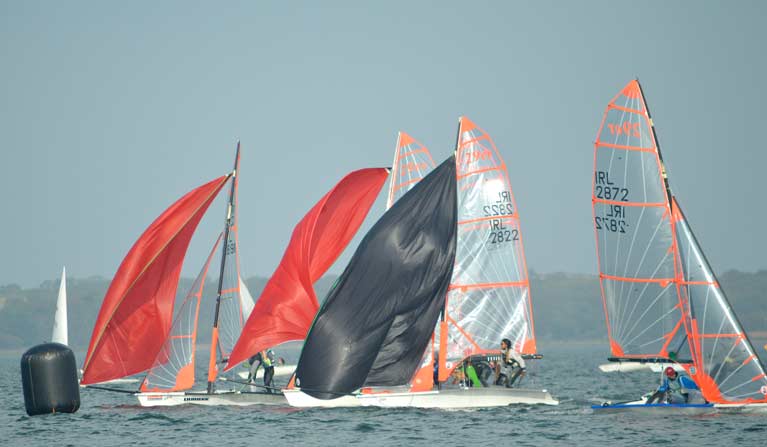 A tight battle at the leeward mark in the 29er fleet Photo: Thomas Chaix
A tight battle at the leeward mark in the 29er fleet Photo: Thomas Chaix
Day 2's forecast was good with a southerly due to head west by midday. The proceedings were a bit slow but the fleet eventually started race 4 in a medium southerly. Early leaders Cullen-Hogan were overtaken by McDonnell-Van Steenberge. The two boys were not seen again scoring their third race win of the event. The Kohl's siblings had to work their way up the fleet and secured yet another 2nd. The next race started in a dropping breeze and the expected right shift came mid race.
The race officer decided it was just that bit too much and the race was abandoned, which set the scene for a final race drama. The equation was simple enough yet required good sailing skills and clear knowledge of the rules. Having added the points, the Kohl's sibling were starting the final race with a guaranteed 2nd overall and a low discard. On the other hand, McDonnell-Van Steenberge were clear leaders yet discarding a high points first race. The Kohl's made their intentions clear in the first beat taking control of the boys windward side and started to sail them off the course in a very skilled and determined fashion. When the pair eventually made it to the windward, The boys had been put into last position with a monumental task in hand to save their event win.
The opportunity came to overtake their tormentor at the leeward of the initial lap when a 420 allowed a split between the two boats. They certainly took their chance and started to look at the fleet ahead with 3 boats still within reach. At the end of the second lap, they managed to overtake 2 boats which was just about enough to reclaim their lead. It was very tense as they held 6th to the finish which meant the countback went to their favour for the Northerns title. Lola and Atlee Kohl settle for 2nd but secured
the Triple crowns overalls. Completing the podium were Elysia O'Leary and Chris Bateman.
The second year of existence of the 29er class in Ireland has seen major progress in the level of skills and the next challenge is now to grow the numbers of partnerships attending open events... In the mean time, everyone is preparing a solid winter of training to develop further their skills... Bring on 2020!
Dublin 29er Duo Win RYA Northern Ireland Youth Championships
Dubliners Rian McDonnell Geraghty and Nathan Van Steenberge from the National Yacht Club were the nine-boat 29er class winners at the 2019 RYA Northern Ireland Youth Sailing Championships at Strangford Lough Yacht Club at the weekend.
Over 140 boats overcame some challenging wind conditions on both days to enjoy some great end of season racing on the Lough for the 30th edition of the RYA event.
In the 420 class, East Antrim and Malahide duo of Lucy Kane and Emma Gallagher were winners of the ten boat fleet.
County Antrim's Ellen Barbour was the 15-boat Laser 4.7 winner with Royal St. George's Tom Higgins from Dublin Bay the winner of the 27-boat Radial fleet.
The Topper 5.3 fleet, the biggest of the regatta with 35 entries, was won by Ballyholme's Hannah Dadley-Young.
Download full results below
Royal Cork's Kohl & Bateman in Top Ten of 29er Europeans
Royal Cork's Atlee Kohl (18) and Chris Bateman (18) sailing for the US Virgin Islands are seventh overall after the second day of the 29er European Championship on Lake Garda, Italy with winds at 9 to 12 knots, a bit lighter than Monday.
Kohl and Bateman who won the RS200 Nationals in Galway Bay ten days ago have switched roles for the Italian event.
The top Irish duo of nine competing crews is Charlie Cullen (17) and Ben Hogan (17) of the Royal St George Yacht Club.
Seven of the scheduled 9 races have now been completed for the 210 crews competing.
Eight different nations are in the top 10 so far and the gold fleet will see the top 50 crews compete starting today.
Final top ten after 7 races, 1 discard
1. Mathias Berthet / Alexander Franks Penty, NOR, 7 net points
2. Aristide Girou / Noah Chauvin, FRA, 14
3. Ville Korhonen / Edvard Bremer, FIN, 17
4. Marius Westerlind / Olle Aronsson, SWE, 17
5. Finn Walter / Marcus Borlinghaus, GER, 19
6. Ewan Wilson / Finley Armstrong, GBR, 22
7. Zeno Biagio Santini / Marco Misseroni , ITA, 23
8. Jens-ChristianDehn-Toftehoj / Mads Fuglbjerg, DEN, 25
9. Oliver Evans / Will Jarman, GBR, 27
10. Freya Black / James Grummet, GBR, 28
Full Results are downloadable below
Youth sailors from the Irish 29er fleet travelled to Gdynia, Poland to compete in the Zhik 29er World championships held last week, from Friday 26th to Saturday 3rd August writes Chris Bateman (17), a member of the Irish contingent that teamed up with the US Virgin Islands.
Two years ago, three Irish sailors competed in the 2017 29er World Championships in California. Since then our 29er fleet has grown steadily and to demonstrate that growth eight Irish sailors competed in this year's Worlds in Gdynia.
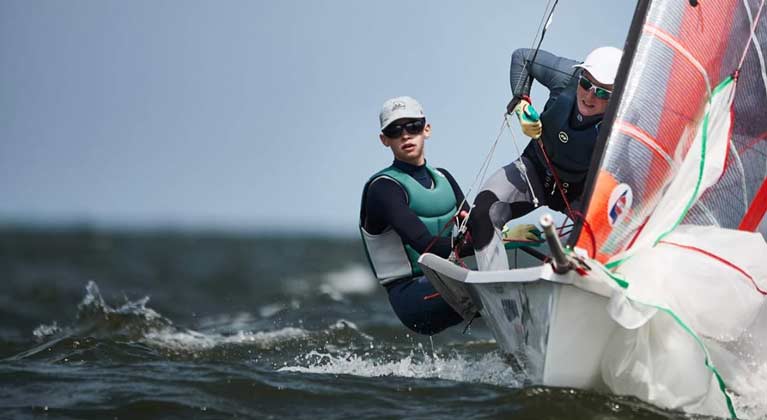 Charlie Cullen and Ben Hogan
Charlie Cullen and Ben Hogan
This year Ireland had great representation, with three full Irish teams competing. These teams were Harry Twomey and Harry Durcan (RCYC), Charlie Cullen and Ben Hogan (RStGYC), and Lola Kohl with Johnny Durcan (RCYC). Also competing, and sailing on a mixed Irish/US Virgin Island team were RCYC 29er sailors Sophie Crosbie, Dawson Kohl, Jonathan O’Shaughnessy, and Chris Bateman.
 Lola Kohl and Johnny Durcan
Lola Kohl and Johnny Durcan
Gdynia is a beautiful place at this time of year, and the Irish competitors took no time in rigging their 29ers on the white sand beach opposite the city. With the event due to commence Saturday morning, boat preparation was finished a few days prior.
A light forecast was in store for the week, which held true for the first day of racing. The first gun was due for all fleets at 11 am but winds under five knots forced the sailors to stay ashore. A fickle breeze came in the afternoon, enough to send out the competitors. The light breeze suited the Irish, with every team doing well in their respective fleets. The race of the day went to Harry Twomey and Harry Durcan, scoring a sixth in race one.
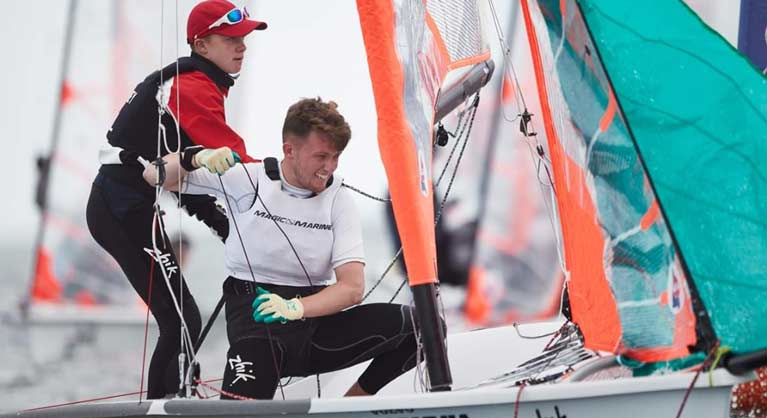 Harry Twomey and Harry Durcan
Harry Twomey and Harry Durcan
Day two proved the forecast to be wrong, with grey clouds and 15 to 20-knot winds blowing across the beach. But warm water awaited and all 178 competitors launched in good time for the traditional 11 am start. There were thrills and spills, with a big chop and strong winds making the racing tough. The Irish sailors had two bullets, with Lola Kohl and Johnny Durcan winning the first race. Harry Twomey and Harry Durcan won the last race of the day.
The sun shone down on Gdynia beach for day three of racing. A cloudless sky allowed for a thermal wind to fill in, which gave the sailors a light wind day of racing. Steep chop made the races very tough. Massive wind shifts caused chaos on the course. Luckily the Irish sailors stayed fully focused, and remained conservative to hold high positions.
Launching on day four (Wednesday) was a quick process, but a lack of wind forced the race committee to send the sailors ashore to wait for wind. This meant that the main aim of the day was to search for shade and have some fun. Unfortunately, the wind level stayed too low and racing was abandoned for the day.
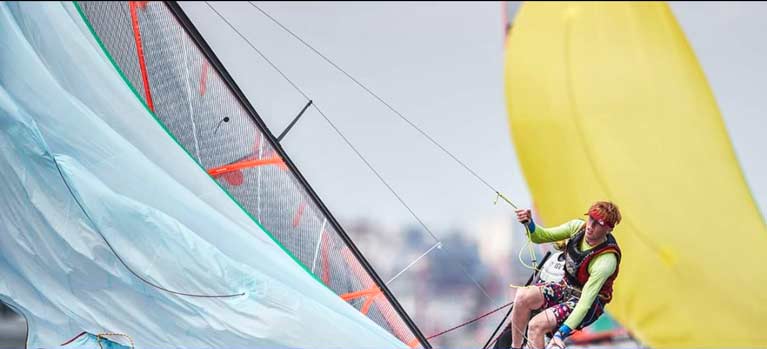 Lucy Klempen and Chris Bateman on the wire
Lucy Klempen and Chris Bateman on the wire
Day five dawned with the sun splitting the stones and a gentle 10-knot breeze blowing. Four races were scheduled, with the usual first gun at 11 am. The wind increased dramatically as the day went on, and by the last race of the day, a steady 18- 24-knot breeze was blowing. These heavy winds tested the Irish sailors to their limits. The races of the day went to two teams, Charlie Cullen and Ben Hogan, with a fifth and a third in the bronze fleet, and Lucy Klempen with Chris Bateman, scoring fifth in the final windy race in the silver fleet.
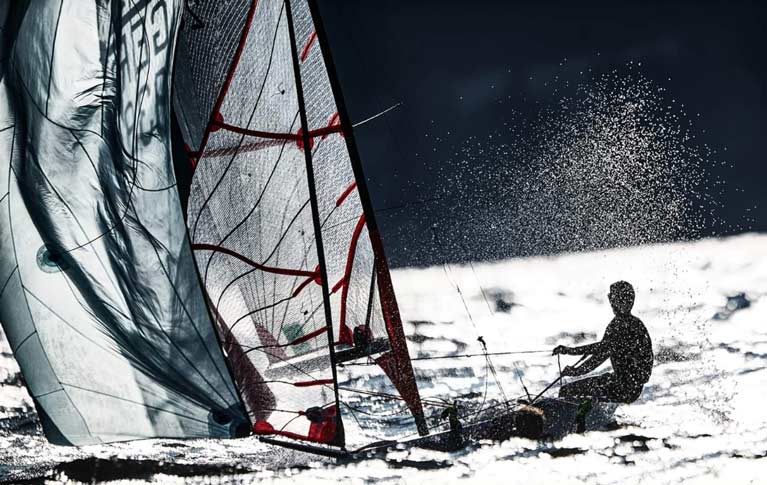 Day 5 - strong winds
Day 5 - strong winds
Day six, the final day of racing rolled around. Sunny conditions brightened the atmosphere on the beach. The points were still very close, and there was a lot to be lost and gained. A very light five-knot breeze blew on the course, making perfect sailing the only option for success. Two Irish teams sat in contention for a top 20 finish. Four difficult races were held, with both teams holding up well in the conditions.
Racing over, the closing ceremony officially ended the event on Saturday 3rd August. RCYC sailors Harry Twomey and Harry Durcan had a top-class performance, finishing in an astonishing ninth place out of 178 boats as Afloat previously reported here. Fellow Cork sailors Lola Kohl and Johnny Durcan finished in 16th place, having held on to a great top 20 result.
All of the team did great, proving that not only can you race competitively, but you can also have fun and make lifelong friends from other parts of the world. And with the rapid growth of the Irish 29er fleet, the fun will continue not just abroad, but on our home waters too.




























